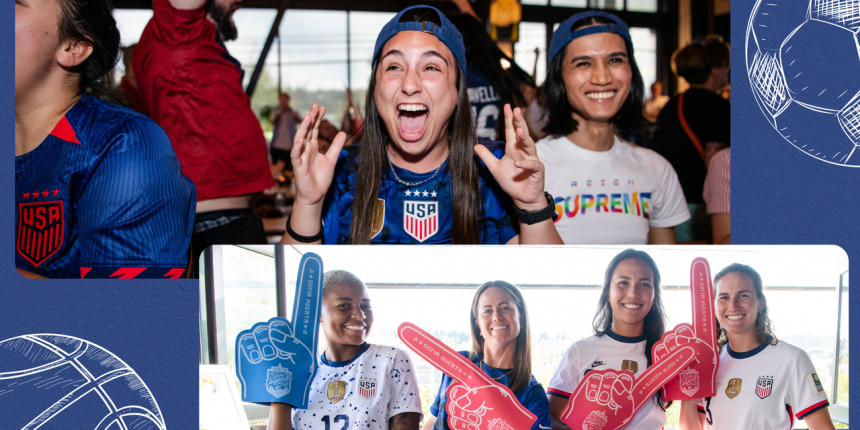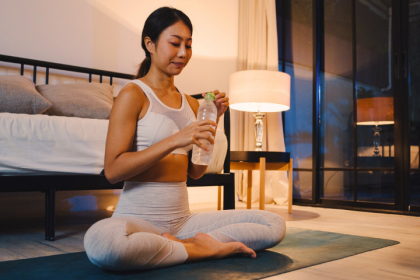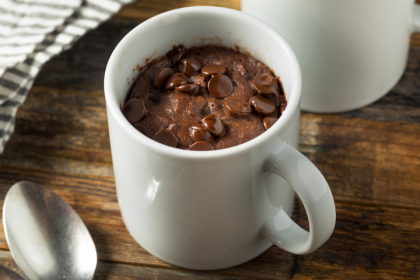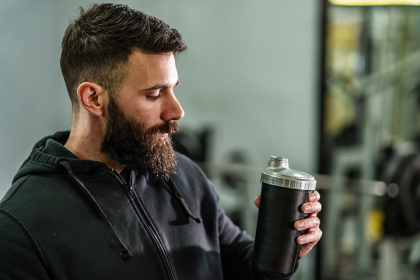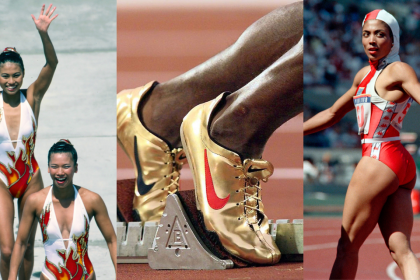Root for your team, make like-minded friends, and enjoy a beer without someone mansplaining free throws.
.png)
Jane G Photography / Amanda K Bailey
As Serena Williams volleyed back and forth with Ajla Tomljanovic during her final tennis match in September 2022, 4.6 million viewers (an ESPN record for the sport) tuned in. And a bunch of them were watching from the Sports Bra in Portland, Oregon, which grew so silent you could hear a potato chip drop to the floor—despite a crowd that spilled into the street, where fans cupped their hands over the glass windows to watch the action inside.
“Every time Serena would win a point and let out her victory scream, the entire place was on their feet,” owner and chef Jenny Nguyen, who had opened the bar just six months earlier as a way to showcase women’s sports and empower female athletes, tells SELF. “When I felt like the end was coming, I ran to my office and grabbed two boxes of tissues. I wasn’t sure if anyone was going to need them, but I definitely was. Sure enough, when the match ended, we just passed those boxes around. There was this moment of oneness and community that felt so special to me.”
It’s a memory that recently came full circle for Nguyen: In April 2024, Williams’s husband, Alexis Ohanian, announced that he’s backing Nguyen’s plan to expand nationwide. For years, we’ve been told “no one wants to watch women’s sports,” but the demand for a space like the Sports Bra is proof that this just isn’t true.
And fans don’t necessarily need to wait for the Sports Bra, which is believed to be the first bar in the US to only show women’s sports events on television, to come to their city. Other similar spots are starting to pop up across the US—Watch Me in Long Beach, California; The 99ers in Denver; Babe’s in Chicago; and Althea’s in New York City—to meet the needs of a growing fanbase.
There’s never been a better time for it. After the frenzy surrounding the women’s NCAA basketball tournament and the WNBA draft earlier this year, and with the 2024 Olympic Games—the first in history to have an equal number of male and female athletes competing—fast approaching, the momentum behind women’s sports keeps growing. And these bars just might help keep it going, showing that all this interest is more than a moment.
Not your average sports bar
When patrons walk into Minneapolis’s A Bar of Their Own—which opened in March 2024—they’re immediately greeted by a Minnesota Lynx jersey, a poster of WNBA star Maya Moore, and other memorabilia celebrating female athletes covering the walls (along with, of course, women’s games playing on the televisions). “People are just so quickly caught off guard by women being prioritized,” owner Jillian Hiscock tells SELF.
It’s not just the decor and the programming that puts women front and center. These new spaces ditch the traditionally dark and dingy sports bar setting for something lighter and more welcoming; the Sports Bra, which seats just 40 people, has 16-foot ceilings and communal tables that contribute to a cozy neighborhood feel; Rough & Tumble Pub, which opened in Seattle in December 2022, is housed in an old sawmill that can fit about 250 customers and has floor-to-ceiling windows that beckon potential fans in off the street. They’re often a stark contrast from typical male-dominated spaces, with their basic bar fare and seemingly nonexistent design strategy beyond “more TVs!”
“I built the Bra for myself: I built a space that I felt comfortable in, and it turned out that what made me feel at home is something that makes a lot of people feel at home,” Nguyen says. “And it wasn’t until I did that that I realized how traditional sports bars came up short for a lot of people.”
“Most sports bars are hyper focused on men’s sports and are full of people who are very aggressive about their sports fandom,” Terrence Streetman, a 38-year-old from Kankakee, Illinois, and a long-time Chicago sports fan who’s struggled to convince traditional sports bars to play women’s games, tells SELF. “The environment can be very off-putting, and especially not welcoming [for] women and/or queer patrons.”
With women’s sports bars, there’s an understanding that you don’t need to look or act a certain way for your fandom to be legit. “More often than not [in traditional sports bars], I’ve been pushed to ‘prove’ I know what I’m talking about or been told that I’m not a real fan,” Kalli Ringelberg, a 34-year-old from Montreal who’s planning a road trip to visit several US women’s sports bars with her friends, tells SELF. With women-focused spaces, you have the “freedom to be a casual fan,” as Ringelberg says—though that doesn’t necessarily mean the patrons are any less committed. As Streetman puts it, “Women’s sports bars—and sporting events—still have passionate fans, but there’s less of the in-your-face aggression that you’d see at a ‘traditional’ sports bar.”
And it’s not that there aren’t men at these bars—because men do, in fact, watch women’s sports. “The type of men we attract aren’t traditionally the kind that are mansplaining how football works to women,” says Hiscock. The result? A space that’s not only more welcoming to die-hard supporters, but one that provides an easier on-ramp to potential new fans so all patrons feel like they belong.
Building a strong community, one sport at a time
Going to a women’s sports bar is about more than simply finding a place that broadcasts your team’s game; it’s about finding your people. “I’ve played sports my entire life and there was never a women’s sports bar around,” Ashley Jones, a 36-year-old from outside of Chicago who started making the 45-minute drive to Whiskey Girl Tavern three years ago to watch Chicago Sky games, tells SELF. “It’s a phenomenal experience to be around other women who love sports as much as I do.” These bonds can translate outside the bar too; she now attends games with people she met at the bar.
“Being at a sports bar like this, a place where you belong and feel like you belong, is very powerful,” Nancy Lough, EdD, professor of sport management at University of Nevada, Las Vegas and Title IX consultant, tells SELF. These spaces play a very significant role as a safe place, she adds—a “sanctuary,” as Jen Barnes, the owner of Rough & Tumble Pub, puts it. “Safety can be psychological, meaning being free to cheer for your team and speak openly about the action, or physical, meaning women are far less likely to be ‘hit on’ when attending a bar dedicated to women’s sport,” explains Lough.
Because women’s sports bars are built with inclusion in mind, they often cater to lots of marginalized groups. “We worked really hard to be intentional about making this place accessible and community-oriented,” says Hiscock. That’s why she says they consulted with folks in wheelchairs when creating A Bar of Their Own’s floor plan—an accessible table is located close to the main entrance, and Hiscock worked with the city to secure permanent accessible parking on the street directly in front of the entrance instead of at the rear of the building. The space also has gender-neutral restrooms.
At the Sports Bra, the diverse menu accommodates a myriad of dietary restrictions—you can easily order dairy-free, gluten-free, and vegan options—and nonalcoholic drink options. “We try to source from local women-owned and -operated businesses as much as we can,” says Nguyen.
Even if these bars show only (or mostly) women’s sports, they aren’t designed just to attract women. “These are not just places where only women congregate; this is where people who care about women’s sports get to go watch and be engaged in on a whole other level,” says Lough. As a result, many of the women’s sports bars actually have a pretty diverse clientele.
Take, for instance, Rough & Tumble’s customer base, which Barnes estimates is 55% women, with a huge trans and queer community. The Sports Bra has a balanced female-to-male ratio, and is an all-ages, family-friendly bar that allows minors until 10 p.m. And A Bar of Their Own is an all-ages, queer-friendly space with crowds that are about 70% women and 30% men on any given night. “We very intentionally created our space so that it could be family-friendly, because we want young girls and boys to be in here seeing women’s sports on TV as the norm,” says Hiscock.
So while most are openly LGBTQ-friendly, they’re not exclusively queer or lesbian bars. As Hiscock describes it, “We firmly believe that queer women need a space to belong, but we’ve been very adamant that we’re not a queer bar because we really want people of all walks of life to be able to watch women’s sports in a safe space.”
Elevating women’s sports beyond 2024
It’s undeniable that women’s sports are having a “moment,” but players and fans want—and deserve—more than that. Growing the fan base by providing a safe space to watch, mingle, discuss, and learn is crucial for keeping this year’s momentum going and creating something that lasts.
Just having basic access can go far. So many women’s games are still paywalled on streaming platforms—Peacock, YouTube Premium, Amazon Freevee, FuboTV, Sports.tv, Tubi, and Xumo, among others—and it’s often hard for fans to justify shelling out cash for multiple subscriptions. (For instance, if you don’t have cable and want to watch the WNBA on ESPN+, that’s $10.99 per month. Want to tune into the National Women’s Soccer League too? Prime Video will run you another $8.99 per month.) With men’s sports, on the other hand, it’s easier to become casually interested or involved, since a football, baseball, or basketball game is often just a click away on network TV—or a glimpse away at your local watering hole. All of this can make it hard for an audience to develop and for women’s sports to grow.
But if you go to a women’s sports bar, the game is right there waiting for you; you don’t need to seek out specific apps, search a schedule, or make a set plan. For the bars, providing that access is a way of demanding more content, which is crucial in the development of women’s sports. “We play a really critical part in building the fan base through viewership,” says Barnes. Media drives the interest that creates the fandom, and the more viewers these games get, the more likely platforms are to put money back into that sport. This can look like more and better quality merch options for teams, or increased media coverage from mainstream channels and outlets to further increase visibility and accessibility, says Lough.
“For a long time, watching women’s sports was a solitary and frustrating experience: sitting at home, trying desperately to figure out which streaming service—usually paid, if any—had the game as an option,” says Streetman. “Having these spaces makes it easier to access games and be among other fans, which is such a key part of building a relationship with a sports team.”
At the same time, the more accessible women’s sports are, the more likely folks are to watch and shell out the cash to support them—in a bunch of ways. “Women’s sports bars not only help the female fans that exist continue to watch, continue to buy merch, and continue to buy tickets,” says Hallum. “But if we can bring in the men and families as well, they’ll see how exciting women’s sports can be and increase their viewership and what they spend.”
It’s an “if you build it, they will come” situation. “People said ‘no one’s interested in women’s sports,’’ says Lough. “How can there be interest if you don’t build an audience? Bars like this build the audience. Turns out, people are interested in women’s sports. Look what happens when we put it on accessible channels. The viewership grows exponentially.”
Need proof? The 2024 women’s basketball national championship was the most watched basketball game—men’s, women’s, pro, college—since 2019, with an average of 18.9 million viewers. A $240 million, four-year TV deal recently went into effect for the National Women’s Soccer League, and they saw a 95% increase in total viewership. The Professional Women’s Hockey League launched in 2023 and experienced a 2,557% increase in YouTube subscribers over their first season.
So yes, this interest is more than a moment, it’s a movement—one “that’s been very long in coming,” says Lough, or, more specifically, 52 years in the making, since Title IX passed in 1972. Now that it’s here, it’s our duty to help it thrive. Women’s sports bars, and the fans they bring in, can help keep that momentum going long after the frenzy around individual events like NCAA March Madness and the Summer Games dies down. If you’ve already got one of these bars in your area, give it a go—you might find a new sport or community you’re passionate about. And if you don’t have one nearby, the Sports Bra is now taking franchise applications.
Related:
- Who and What to Watch For at the 2024 Summer Games
- Dominique Moceanu, Shannon Miller, and Dominique Dawes Take a Victory Lap
- What It’s Actually Like to Live in the Olympic Village, According to the Athletes
Get more of SELF’s great service journalism delivered right to your inbox.
SELF does not provide medical advice, diagnosis, or treatment. Any information published on this website or by this brand is not intended as a substitute for medical advice, and you should not take any action before consulting with a healthcare professional.
